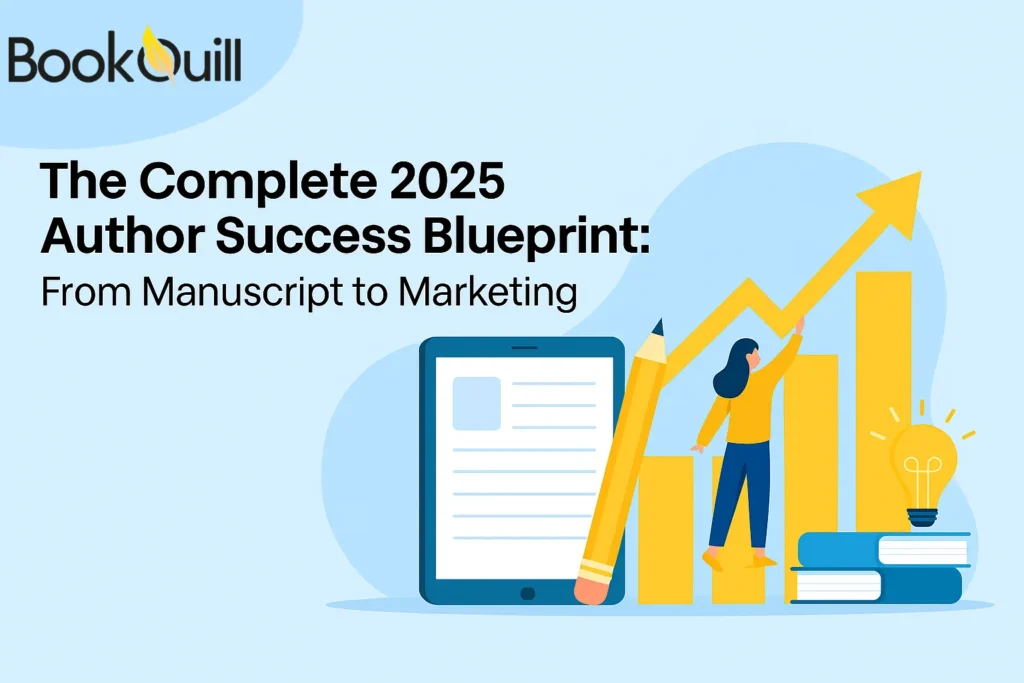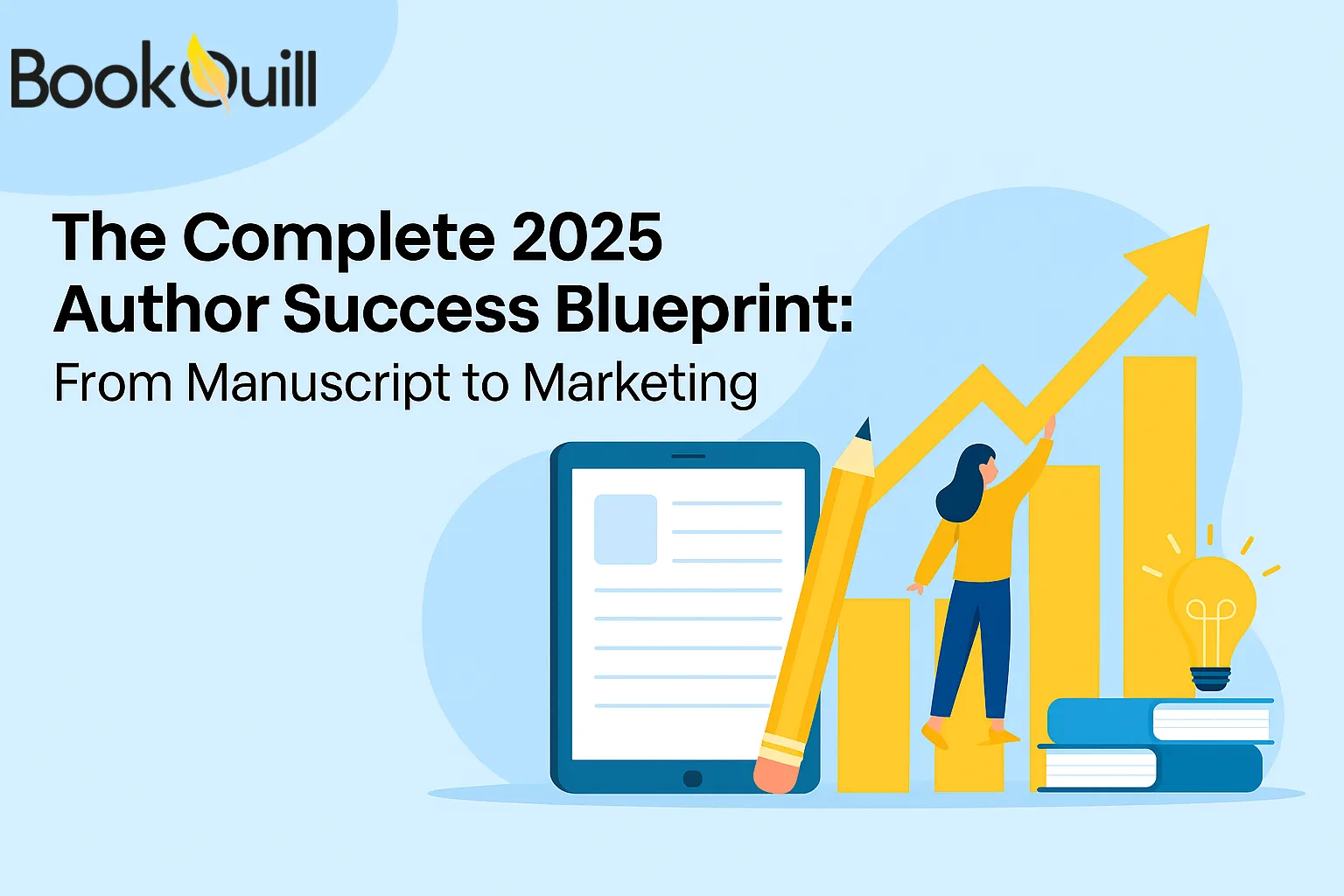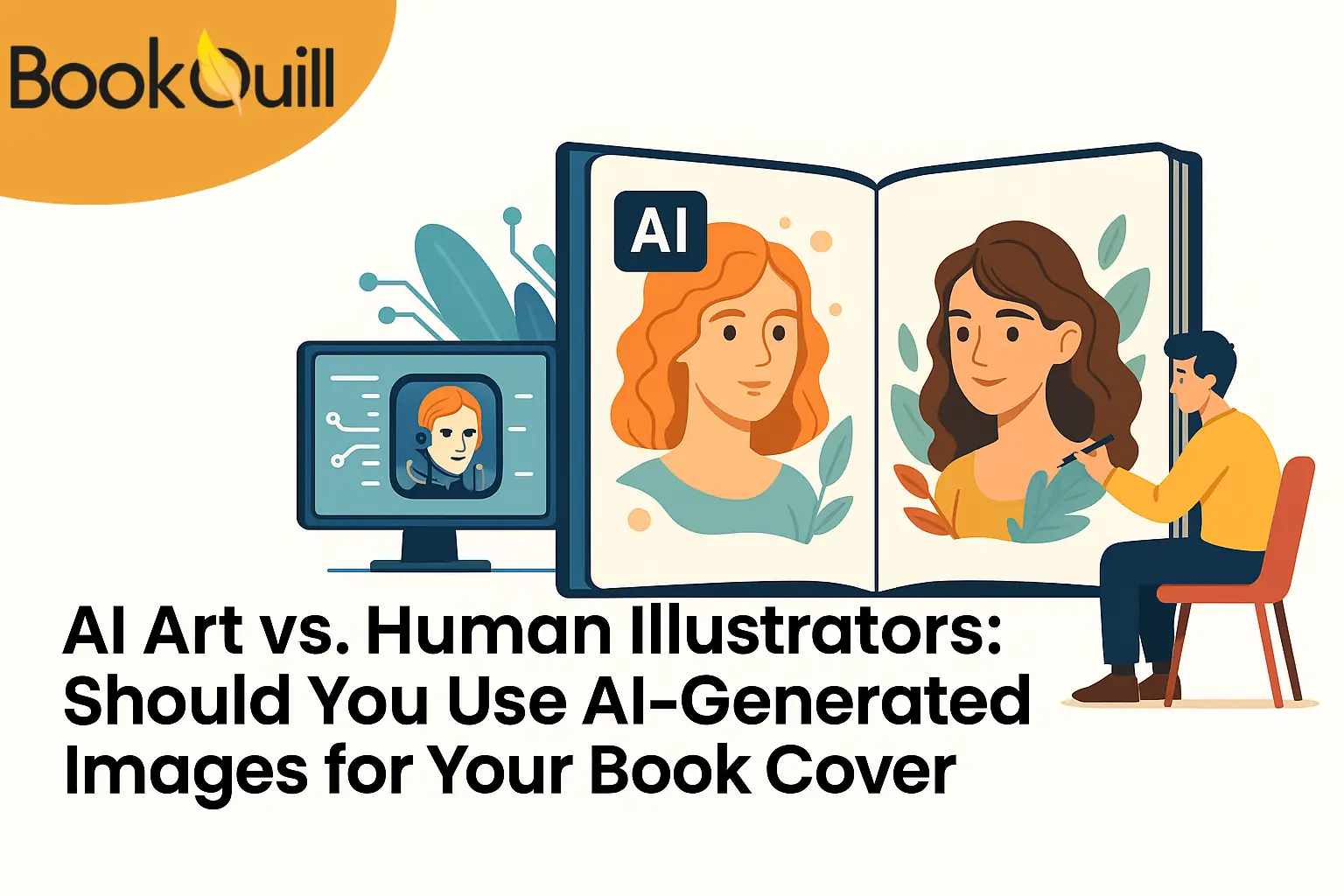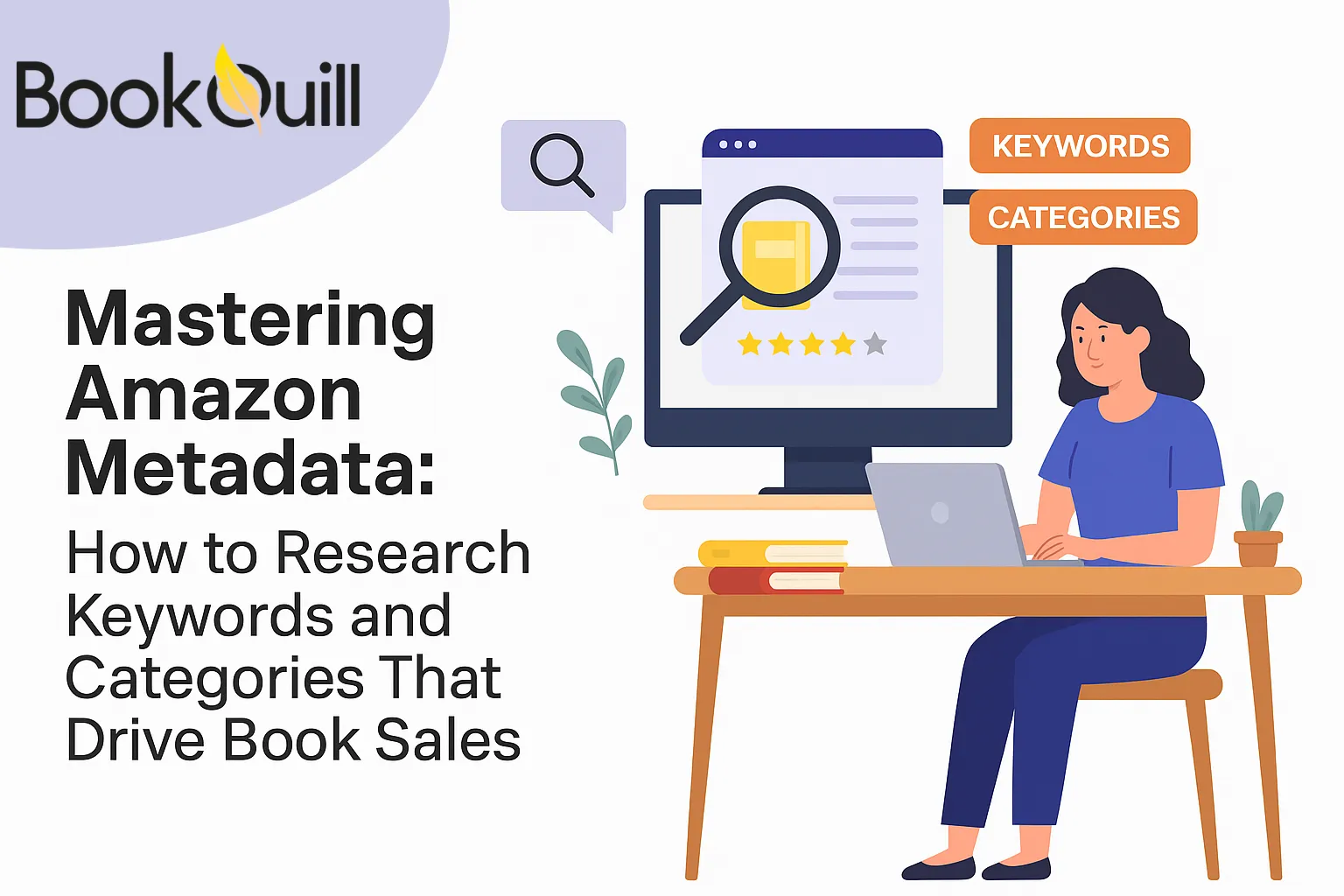Table of Contents
Explore Blogs
Trending on Ebook
The Complete 2025 Author Success Blueprint: From Manuscript to Marketing

So why do you need a success blueprint and not just a good book?
Every year, between 500,000 and 1 million new books are published.
That means having a finished manuscript is no longer the finish line; in 2025, it’s just the starting point. To stand out, you need an author success blueprint. It’s what guides you from simply having a book to actually reaching readers and building momentum.
For example, let’s say an architect is drawing your career. It would start from laying your foundation (writing your manuscript) to adding the final coat of paint (marketing and branding). And without this blueprint, you might end up with a book-shaped shack that nobody wants to live in. But with one, you are building a house that readers actually line up to enter.
So, yes, it isn’t just about finishing your book. It’s about building a career that keeps readers coming back for more. And today, authors need to be more than just writers; they should be marketers, designers, business owners, and sometimes even narrators. And we know that can sound overwhelming, but it’s also the reason why having a blueprint matters more than ever.
That’s why we are here with an author guidebook. Or call it your 2025 master plan, a plan for authors who want to thrive. We’ll walk you through every stage from writing, editing, design, publishing, distribution, marketing, branding, money, mindset, and beyond.
By the end, you’ll have your very own blueprint from manuscript to marketing, with a little humor, personal confessions, and yes, the checklists you’re craving.
Key Takeaways
- An Author Success Blueprint is your guide from manuscript to marketing so your book thrives in 2025’s crowded market.
- Editing, design, and distribution aren’t extras; in fact, they’re the foundation of professionalism, and skipping them can bury your book fast.
- Smart marketing tools like email lists, book trailers, and a strong digital marketing blueprint make the difference between visibility and insignificance.
- Partnering with professional book writing services helps transform a draft into a market-ready product that builds long-term author success.
- Longevity comes from persistence, branding, and consistency, whether you choose premium or affordable professional book writing services, invest wisely in your career.
The Manuscript Stage: Writing Like It Matters
Every blueprint starts with a foundation. For authors, that foundation is the manuscript, your draft, the messy pile of words that will eventually (hopefully) become a book someone can’t put down.
Now, let’s set the record straight! Your first draft is not a book. It’s a mixture of plot holes, dangling subplots, characters who change eye color halfway through, and dialogue that sounds like it was lifted from a soap opera. And honestly, that’s normal.
Remember, the goal of this stage isn’t perfection, it’s creation.
Habits: Writing Without Losing Your Mind
Writing is 20% inspiration and 80% just showing up.
Authors who wait for inspiration usually end up binge-watching Netflix while their unfinished manuscript gathers dust. Thus, we recommend setting a schedule, for example, write 500 words before breakfast or 2000 words on Saturdays. This consistency can help you complete your book.
When I wrote my first book, I thought I’d be disciplined. I bought three new notebooks, color-coded pens, and even a timer. But guess what? The only thing I produced consistently was some sketches and pictures. The real breakthrough came when I ditched the tricks and forced myself to type at 6 a.m. every day, coffee in hand.
Tools: Writing in 2025
Goodbye, excuses, because technology has made writing less lonely and more efficient.
- Scrivener for structuring (a lifesaver for long manuscripts).
- Notion or Obsidian for organizing research and worldbuilding.
- Focus apps like Freedom that block TikTok when you’re supposed to be writing Chapter 12.
And yes, AI writing assistants exist; they can brainstorm, outline, or punch up dialogue. But remember, they’re like your intern. Useful, but don’t let them run the company.
Beta Readers: Your Early Test Audience
Would you ever build a house without taking advice or suggestions from an expert? In the writing industry, these experts are beta readers. These early readers spot issues you can’t because you’re too close to the story. They’ll tell you if your pacing drags, if your hero is unlikable, or if your brilliant plot twist was painfully obvious from page ten.
And we know what you are thinking, maybe editors can help you here. Well, sure, editing will do the cleanup, but without this stage, you’ve got nothing to clean up.
And remember, your manuscript is more than words on a page. It’s the first brick in your author guidebook, the step that gives every other stage something to build on.
Editing: Where Good Books Become Great
Writing gives you the raw material, but editing is what shapes it into something worth reading. Editing is where your messy draft gets cleaned up, fixed, and polished. It’s the step that makes your ideas clear, your sentences flow smoothly, and your story or message actually connect with readers. Without editing, your work stays rough and unrefined; it is something you wrote for yourself, not something others would want to pay for or enjoy.
With that being said, remember that even brilliant ideas need editing. The books we call “classics” didn’t just come out of their authors’ heads. They were rewritten, torn apart, stitched back together, and polished until they shone.
The Editing Spectrum: What You Actually Need
There are three main levels every serious author should know:
1. Developmental Editing
This is the “does your house have a roof?” stage. A developmental editor looks at your story as a whole, like plot, structure, pacing, character arcs, and logic. They’re the ones who’ll tell you if your words don’t land the way you thought they did, or when a side character starts pulling attention away from the story you meant to tell.
2. Line Editing
Now we’re zooming in. This level examines your sentences, flow, tone, and clarity. Are you overusing adverbs? Is your dialogue clunky? A line editor smooths out your sentences so the writing feels natural and effortless to read.
3. Copyediting & Proofreading
The grammar cops. They catch the typos, the misplaced commas, the “their/there/they’re” disasters. It’s about making sure everything is clear and consistent, so readers never get confused or pulled out of the story.
Why Editing Hurts and Why That’s Good?
Honestly, the first time I got a developmental edit back, I considered throwing my laptop into a river. It was 20 pages of “this doesn’t work,” “rewrite this,” and “maybe cut this character entirely.”
But here’s the thing! Once I stopped grumbling and actually applied the changes, my book improved tenfold. Editors aren’t there to crush your soul. They’re there to build a framework around your story so it doesn’t collapse.
Editing in 2025: Tools and Trends
Authors today are spoiled, in the best way. Alongside human editors, we’ve got tools that make the process smoother:
- Grammarly and ProWritingAid help catch surface errors.
- AI-driven editing tools flag pacing issues or tone inconsistencies.
- Collaborative editing platforms make working with multiple editors and beta readers a lot less chaotic.
But the real deal is, tools are helpers, not replacements. If you’re serious about building a career, you’ll need premium book writing help at some stage. And yes, that costs money. But it’s an investment, because an unedited book doesn’t just fail, it actively drives readers away.
Editing and Your Author Success Blueprint
Editing is the wiring of your blueprint. It’s invisible when done right, but catastrophic if skipped. Readers won’t praise your perfect grammar, but they’ll definitely roast you in reviews if you mess it up.
So, ask yourself! Are you willing to let your story remain “good enough,” or do you want it to be great? Because in 2025, with readers bombarded by choices, “good enough” gets you lost in the shuffle. But great gets you remembered.
This is where affordable professional book writing services come into play, because editing is oftenn’t just about tweaking a manuscript. It’s about reshaping your story with the help of skilled professionals who understand structure, flow, and market trends.
Design That Sells: Covers, Fonts, and First Impressions
Yes, readers absolutely judge books by their covers. They shouldn’t, but they do, and in 2025, when a book has about three seconds to catch a potential buyer scrolling on their phone, your design is either your greatest catch or your fastest downfall.
Your book cover is the first impression readers get. Even if the writing inside is brilliant, a dull or sloppy cover can turn people away before they ever give it a chance. A strong, professional design tells readers your book is worth their time.
Why Ugly Covers Kill Books
You know those covers that look like someone mashed clipart into Microsoft Paint back in 2004? Yeah, those. They don’t just fail to sell books; they actively repel readers. Even friends and family will hesitate to share a poorly designed book because, deep down, they know it looks amateur.
And let’s not forget fonts. The wrong fonts can derail even the strongest concept. A romance novel with horror-style lettering? A serious memoir with bubble letters? It’s a mismatch that leaves readers confused and makes your work feel less polished.
The Psychology of Good Design
Design isn’t about making your book “pretty.” It’s about signaling genre, tone, and professionalism.
- Thrillers lean on bold typography, darker palettes, and high contrast.
- Romance thrives on soft tones, elegant fonts, and character imagery.
- Nonfiction usually sticks with clean, bold fonts and uncluttered layouts.
The Role of Illustrations and Visual Identity
Here’s where it gets fun and where most authors miss the boat. Your design isn’t just your cover. It’s your entire visual identity. Chapter headers, interior illustrations, and even custom graphics for book trailers and marketing materials all build trust and brand recognition.
This is where professional illustration services shine. Instead of relying on generic stock images or AI-generated graphics, illustrations can give your book a signature style that feels intentional. Remember, design is the paint job on your blueprint, and readers can smell cheap paint a mile away.
Tools and Options in 2025
- Canva Pro has leveled up with templates personalized for book marketing (great for indies on a budget).
- Freelance platforms connect you with specialized book designers faster than ever.
- But the real difference? Premium book writing companies often bundle writing and design services together, ensuring consistency across your manuscript, cover, and marketing materials. That cohesion is a game-changer.
Publishing Choices in 2025: Indie, Hybrid, or Traditional?
Once your manuscript is polished and your cover looks sharp, it’s time for the big question: “How do you actually get this book out into the world?” In 2025, authors have three main routes. These are indie publishing, hybrid publishing, and traditional publishing, and each comes with its own baggage, benefits, and plot twists.
Think of it like travel:
- Indie = driving yourself (freedom, but you’re on the hook for gas, maps, and flat tires).
- Hybrid = hiring a chauffeur (you share some control and cost, but someone else does the heavy lifting).
- Traditional = taking a plane (prestige and reach, but the airline dictates everything, including your seat assignment and how much luggage you can bring).
Indie Publishing
Indie publishing has exploded in the last decade, and for good reason.
In its most recent report, Bowker found that the number of self-published titles with ISBNs rose 7.2% in 2023 over 2022, topping 2.6 million, another healthy jump for a sector that has more than doubled its output within the past decade.
Self-publishing gives you freedom. You control the rights, royalties, and timeline. Want to publish next month? You can. Want to set your price at $3.99 or $39.99? Totally up to you.
But freedom comes with responsibility. You’re the CEO of your book business. You need to handle editing, design, formatting, distribution, and (gulp) marketing. This is where many authors trip; they underestimate how much work “being their own publisher” really is.
Hybrid Publishing
Hybrid publishing combines indie control with traditional support. You typically pay upfront for services (editing, design, distribution), but you also keep more royalties than traditional authors. The best hybrids act like business partners: you’re investing, they’re delivering.
A good digital marketing blueprint paired with hybrid support can give you the best of both worlds, i.e., speed, quality, and professional presentation without total DIY burnout.
Traditional Publishing
Traditional publishing still has status, a bigger reach, and the chance of an advance. But in 2025, the process is painfully slow. You might spend months finding an agent, years waiting for acceptance, and even longer before your book reaches readers.
And even then, most publishers expect you to do a lot of your own marketing. That’s why professional book writing services matter; the stronger your manuscript and proposal, the better your chances of landing a deal.
Distribution Explained: How Readers Actually Find You
The myth is that once your book is published, readers will somehow find it on their own. The truth is, without a solid distribution plan, your book will likely go unnoticed. Distribution is a core part of any author’s success — it’s often unseen when done well, but impossible to ignore when missing.
What Distribution Actually Means
Distribution isn’t just about putting your book online. It’s about making sure people can actually find it where they already go, bookstores, online retailers, libraries, subscription platforms, or even straight from your own website. The goal is simple: make your book easy to access.
The 2025 Distribution Landscape
In 2025, the distribution game is wider and weirder than ever:
- Online Retailers: Still a major player, but competition is fierce. Without smart metadata and strong presentation, your book gets buried fast.
- Libraries & Educational Platforms: eBooks and audiobooks are increasingly being borrowed digitally. Getting your book into these systems opens doors to thousands of new readers.
- Direct-to-Reader Sales: More authors are selling through personal websites, newsletters, and even social media shops. This isn’t just about money; it’s more about owning your relationship with readers.
- Book Bundles & Subscription Boxes: Curated boxes and genre-specific subscriptions are thriving. Imagine your cozy mystery shipped out in a mystery-themed box with tea and candles, instant brand building.
Marketing: The Make-or-Break Stage
You’ve written the book, refined it, dressed it up in a killer cover, and distributed it. But here’s the thing, none of that matters if nobody knows your book exists. In 2025, marketing isn’t an option; it’s like the oxygen your book needs to breathe.
Marketing Is Dating for Your Book
Think of marketing like setting up your book on a dating app. Without a profile picture (cover), a snappy bio (blurb), and some swipes (ads, outreach), your book is just sitting there, lonely, waiting for a match that never comes.
Readers need to be wooed, enticed, and courted, and yes, sometimes bribed with free chapters or bonuses.
The Author’s Marketing Toolkit in 2025
The good news is that authors have more tools than ever to promote their books. However, the bad news is that everyone else does as well. Standing out means being strategic.
Here’s what’s working now:
- Email Lists: Social platforms rise and fall, but an email list is forever. Platforms like MailerLite make it easier than ever to nurture readers with behind-the-scenes stories, sneak peeks, and launch updates.
- Social Media: TikTok, Instagram Reels, and even niche communities (like Discord book clubs) are powerhouses. But don’t just post “buy my book” 20 times a week. Share relatable content, memes, and micro-stories that hook people emotionally.
- Book Trailers: Yes, readers love cinematic teases. A well-made book trailer can make your book feel like an event, not just a product.
- Reviews & Endorsements: Social proof sells. Early reviews on Goodreads alternatives, book blogs, and credible outlets carry weight.
- Ads: Facebook and Amazon ads still work, but they’re expensive if you don’t know what you’re doing. Pair them with a smart digital marketing blueprint, and you’ll avoid burning through cash.
Marketing Mistakes That Kill Momentum
- Treating marketing like an afterthought.
- Expecting one post to “go viral.”
- Overpromising and underdelivering.
- Ignoring branding consistency.
Where Professional Support Comes In
Most writers didn’t sign up to be marketers. They just wanted to write. But in today’s world, that mindset leaves books collecting dust. That’s why authors often turn to professional book writing services, and not just to shape their manuscript, but to build in a marketing strategy from the start.
Author Branding: You’re Not Just Selling a Book, You’re Selling You
In 2025, readers aren’t just buying your book, they’re buying you. Your voice, your vibe, your brand. If your marketing is the “grand opening,” then branding is the architecture that makes people want to come inside and stay a while.
Why Branding Matters More Than Ever
We live in an era where readers want more than just a story; they want a connection. They want to know the face behind the words, to peek into your process, to feel like they’re part of your world.
Think about your favorite writers. Chances are, you follow them on social media, read their newsletters, and maybe even listen to their podcasts. Their brand pulled you in as much as their book did.
Branding Basics for Authors
Your brand isn’t just visuals like a logo or colors. It’s the voice, style, and personality you show consistently wherever readers find you.
- Author Website: A clean, functional site with an easy way to join your mailing list.
- Social Media Presence: Pick one or two platforms you actually enjoy. Consistency beats trying to be everywhere at once.
- Voice & Tone: Are you witty and casual? Serious and scholarly? Own it and use it everywhere, for example, in your blogs, newsletters, and even your book descriptions.
- Visual Identity: Covers, banners, and social posts should all feel cohesive, like chapters in the same Author Guidebook.
The Human Side of Branding
Readers crave authenticity. Share the messy desk photo. Admit that your “writing playlist” is 90% Taylor Swift and 10% rain sounds. Talk about the rejections you faced before finishing your book. Branding works best when it sounds human.
I once subscribed to an author’s newsletter because she admitted she procrastinated on edits by reorganizing her sock drawer. Did I care about her socks? No. But I cared about her honesty, and I bought her book.
Conclusion
The truth is that every writer in 2025 needs to hear is that finishing a manuscript isn’t the end of your journey. In fact, it’s the beginning of a much bigger, messier, and more rewarding adventure. The author’s success blueprint isn’t just about writing; it’s about building. It’s about turning words into a product, a product into a career, and a career into a legacy.
Think of it like building a house:
- The foundation is your manuscript.
- The wiring and plumbing are your edits.
- The paint job is your design.
- The grand opening is your marketing.
- And your future expansions? That’s branding and mindset.
Skip any of these, and your house might still stand, but it won’t be the kind of home people line up to see. Follow them, and you’ve got something readers want to live in for years.
Remember that the publishing world in 2025 is noisy, crowded, and competitive. More books are being published every year than ever before. That’s the bad news. The good news is that authors who treat their work like professionals and think strategically instead of relying on luck still rise above the noise.
And here’s where leaning on professional book writing services like BookQuill makes all the difference. Be it for polishing your draft, strategizing your launch, or planning your long-term brand, professional support ensures you don’t just write a book, you write a book that thrives.
At BookQuill, we call it the protection that keeps you from falling into the author graveyard and the ladder that helps you climb higher than you thought possible.
So, what’s next for you? Are you going to stop at “I wrote a book,” or are you going to build the career blueprint that carries you from manuscript to marketing and beyond?
Whatever the case, we are here to help! Just reach out, and we’ll get you started in no time!
Frequently Asked Questions
What is an Author Success Blueprint?
An author success blueprint is a step-by-step author guidebook that helps writers move from manuscript to marketing. It covers writing, editing, publishing, distribution, branding, and sales strategies.
Do I really need professional help to publish my book?
Not always, but working with professional book writing services gives you an edge. They make sure your book is polished, market-ready, and aligned with 2025 publishing trends.
How do I promote my book effectively in 2025?
Combine a blueprint with practical tools, like email lists (MailerLite), book trailers, and social media storytelling. Consistency wins over one-off efforts.
What’s the difference between an affordable and a premium book writing company?
Affordable professional book writing services help you get started without breaking the bank, while premium book writing offers in-depth and customized strategies for scaling your author career.
Can book marketing really make or break success?
Absolutely. Even the best marketing books prove that visibility matters. Without smart branding and promotion, a great manuscript risks being ignored.
How do I choose the best book writing service for my project?
The best writing service is one that matches your goals, budget, and genre. Look for experienced professionals who offer editing, strategy, and publishing guidance.
Affiliate Disclosure
Note: Some of the links in this post are affiliate links. This means if you click on them and make a purchase, we may earn a small commission at no extra cost to you. We only recommend products and services we genuinely trust and believe will be useful to our readers. Your support helps us continue creating honest, helpful guides like this one. Thank you!
About Author
Hi My name is Micheal Adams, When I am not watching horror movies and helping my kids with homework or reading my favorite fantasy/supernatural novels – I’m writing to guide aspiring authors. I focus on exploring and simplifying both the technical aspects and the often-overlooked details of book writing and publishing so I can empower new writers to climb the Amazon bestseller list and connect with more readers.





